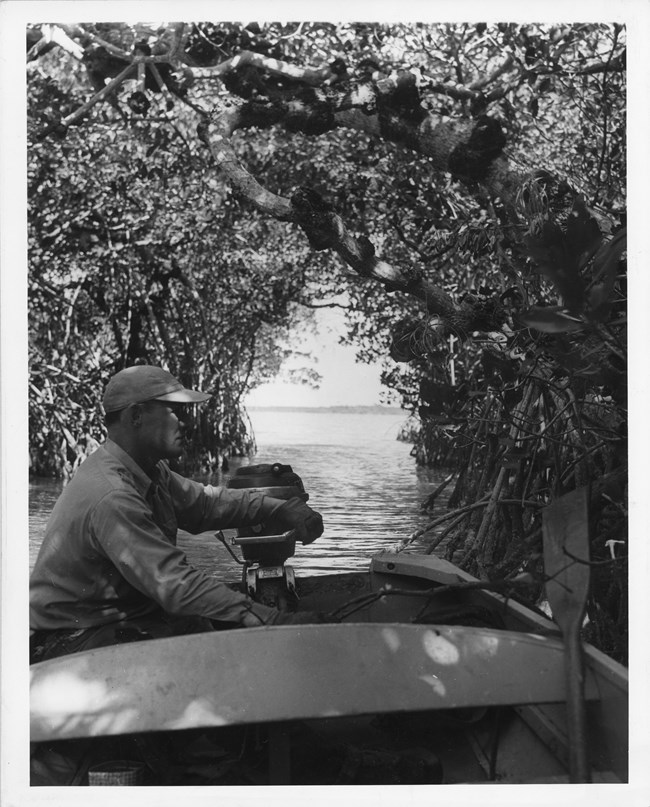
From the earliest days of American photography, the National Park Service has been a constant source of inspiration for photographers, artists, and enthusiasts alike. With a sampling of images found in the Everglades museum collection, we invite you to learn about the role photography has played in the national parks and explore through eminent eyes the extraordinary potential of photography to capture and preserve our country's natural wonders.
The Early Days
In 1871, the Ferdinand Hayden expedition surveyed the American West, including the Yellowstone area of Wyoming. Hayden enlisted the help of photographer William Henry Jackson and artist Thomas Moran to document this unexplored region. Jackson’s photographs and Moran’s paintings were instrumental in convincing Congress to establish Yellowstone as our first national park in 1872.By 1900, the introduction of the compact Eastman Kodak Brownie camera allowed photographers like Ansel Adams to capture the natural world quickly. With this technological advancement, visitors interested in photographing the national parks no longer needed a team of mules to transport their equipment. In 1936, Adams met Harold Ickes, the Secretary of the Interior under President Franklin Roosevelt. Ickes later commissioned Adams in 1941 to create what is referred to as The Mural Project, a collection of images aimed at documenting the department’s mission, landscapes, resources, and the people it serves. Adams completed over 200 photographs before the attack on Pearl Harbor brought his work to a halt. These photographs remain part of the Records of the National Park Service at the National Archives. This project was one of the first large-scale documentary collections of photographs showcasing the diverse resources of America’s national parks.
Eminent Photographers Emerge
The National Park Service (NPS) photography program was established in the 1940s to document the natural and cultural resources of the national parks. The program aimed to create a visual record of the parks that could be used to educate and inspire the public while promoting the conservation and preservation of these important resources. The honorary term "eminent photographer" is often used to recognize the artists responsible for documenting National Park Service sites, resources, and landscapes. The extensive body of work created by these photographers has been featured in books, movies, and publications for over 70 years, yet the artists' names are frequently overlooked when credit is due.While Ansel Adams may be the most famous photographer to capture images of the national parks, many other renowned photographers have also contributed to the NPS photography program. Their vision allows visitors to experience history and the environment through their unique lenses. The images showcase the beauty and majesty of the parks, as well as the rich diversity of plant and animal life, geological formations, and cultural heritage sites found within them.
One eminent photographer in particular, George A. Grant, became the first chief photographer for the National Park Service. A contemporary of Ansel Adams, Grant was hired to create a documentary file of images for the service to use in reports, interpretive projects, education, and other forms of public information. By his retirement in 1954, Grant had amassed a collection of nearly 40,000 images of park service areas, including those in South Florida.
Significance of the Program
The importance of the NPS eminent photographers program lies in its ability to convey the significance of the national parks to a broad audience. These eminent photographers have helped raise awareness of the value of our natural environment and promote the importance of conservation and preservation efforts. Additionally, the photographs produced under this program serve as vital documentation of cultural resources, providing a visual record of the parks over time. The vision of these artists captures moments that enhance awareness, understanding, and appreciation of our national parks for future generations.Click below to explore the work of five eminent photographers who captured the beauty of South Florida's national parks. The images showcase vast landscapes, biological diversity, interpretive experiences between park rangers and visitors, and park architecture. Next, navigate to the photo gallery at the bottom of this page to view a collection of all the images featured in this digital exhibit.

George A. Grant
Grant holds the distinction of being the National Park Service’s first chief photographer. Explore some of his images from the Everglades.

Abbie Rowe
Rowe became the chief photographer for the national parks in the Washington, D.C., area in 1932.

Arthur Fawcett
Active throughout the early 1950s, Arthur Fawcett photographed numerous national parks and historic sites.

M. Woodbridge “Woody” Williams
Williams began photographing the natural world in 1955 while he was working for the National Geographic Society.

Jack E. Boucher
Boucher is best known as an architectural photographer who worked with the National Park Service’s Historic American Building Survey.
Last updated: February 20, 2025
